Would You Pay More for Made-in-the-USA Products? New Study Reveals the Truth

Commitment to Our Readers
GOBankingRates' editorial team is committed to bringing you unbiased reviews and information. We use data-driven methodologies to evaluate financial products and services - our reviews and ratings are not influenced by advertisers. You can read more about our editorial guidelines and our products and services review methodology.

20 Years
Helping You Live Richer

Reviewed
by Experts

Trusted by
Millions of Readers
One of the goals of President Donald Trump’s tariffs is to bring more manufacturing back to the U.S.
“Large and persistent annual U.S. goods trade deficits have led to the hollowing out of our manufacturing base [and] resulted in a lack of incentive to increase advanced domestic manufacturing capacity,” an official White House fact sheet states.
There also seems to be a demand for more American-made products. A 2024 survey conducted by the Alliance for American Manufacturing found that 77% of respondents said they prefer to purchase Made in America items.
But are Americans willing to put their money where their mouth is? To find out if Americans were really willing to pay a premium for Made-in-the-USA goods, Ramon van Meer, a small-business owner and founder of Afina, ran an A/B test — and the results were illuminating.
Will Americans Actually Pay More for American-Made Goods?
For his experiment, van Meer gave customers the option to purchase an Asian-made filtered showerhead for its typical price, or an American-made version that cost more due to higher manufacturing expenses.
“Our bestselling model — manufactured in Asia (China and Vietnam) — sells for $129. But this year, as tariffs jumped from 25% to 170%, we wondered: Could we re-shore manufacturing to the U.S. while maintaining margins to keep our lights on?” van Meer wrote in a blog post explaining his experiment.
“We found a U.S.-based supplier,” he continued. “The new unit cost us nearly three times more to produce. To maintain our margins, we’d have to sell it for $239.”
Van Meer gave customers the option to purchase either the “Made in Asia” version or the “Made in USA” version, explaining that the American-made version was priced higher due to new tariffs and the higher cost of manufacturing in the U.S.
“The results were sobering,” the blog post states.
Over the course of the experiment, roughly 26,000 customers visited the page. Of those, about 3,500 added the Asian-made version to their shopping carts, while only 24 added the American-made version. When it came to actual purchases, nearly 600 purchased the Asian-made version, while zero purchased the American version.
“I expected that the cheaper option would ‘win’ in this experiment, but I thought the split would be closer to 80/20 — 80% [would buy the] cheaper option and 20% of buyers would buy the USA-made one,” van Meer told GOBankingRates. “I was not expecting that nobody would buy the USA-made version.”
What the Experiment Reveals About the Reality of Being a Small-Business Owner Amid Tariffs
Van Meer hopes his experiment helps inform policymakers about the realities of the added costs of manufacturing domestically and what this could mean for sales.
“I hope the policymakers will understand that we, the small-business owners, are the ones that are hurting with these policies,” he said. “We are the ones that have to pay the tariff bills, and some of us will not be able to just simply ‘raise the prices’ because the price will be so high that very few people are willing to pay for it — my experiment kind of proved this point.”
Van Meer also hopes that there can be some relief offered to small-business owners who have had to make quick pivots to accommodate the new tariffs.
“These tariff increases came overnight, with no help for small-business owners to even bridge over the next six to 12 months,” van Meer said. “Lot of small-business owners do not have the cash laying around to suddenly pay 170% in tariffs. I hoped there would have been some SBA loans available for small businesses to help.”
The tariffs will not only hurt small-business owners, but also American workers, van Meer said. And the data backs up this claim — a new report from the Joint Economic Committee Minority found that employment at small businesses with fewer than 10 employees declined by 3% — 366,400 jobs — since Trump took office.
“Now, in order to survive, a lot of these businesses will most likely let go of employees and freelancers to cut costs so they can afford the tariff bill,” van Meer said. “So instead of it ‘bringing back manufacturing jobs,’ it is actually costing us jobs.”
Van Meer is in a better position than many small-business owners, but he is still wary about what the future will hold.
“I am fortunate that we have enough inventory to survive the next six months without getting new inventory shipped from overseas,” he said. “My goal is to find a way to move my manufacturing out of China and move it to Vietnam, Indonesia or another country.
“In the meantime, I will keep trying to see if we can find a manufacturer here in the U.S., but so far I had very, very little luck,” van Meer continued. “[Manufacturing] filtered showerheads is pretty specialized process and there are simply no manufacturers here that make them, and specially not at our scale.”
More From GOBankingRates
- Nearly 1 in 3 Americans Hit by a Costly Holiday Scam, Norton Survey Shows -- How To Avoid This
- Here's What the Average Social Security Payment Will Be in Winter 2025
- How Middle-Class Earners Are Quietly Becoming Millionaires -- and How You Can, Too
- The Easiest Way to Score $250 for Things You Already Do
Sources
- The White House, “Fact Sheet: President Donald J. Trump Declares National Emergency to Increase our Competitive Edge, Protect our Sovereignty, and Strengthen our National and Economic Security”
- Alliance for American Manufacturing, “New Poll Finds Americans Still Very Much Prefer Made in America Goods”
- Afina, “Everyone Says They’ll Pay More for ‘Made in the USA.’ So We Ran an A/B Test.“
- Joint Economic Committee Minority, “Price Hikes and Layoffs: The Impact of Tariffs and Tariffs Uncertainty on Small Businesses”
 Written by
Written by  Edited by
Edited by 

























